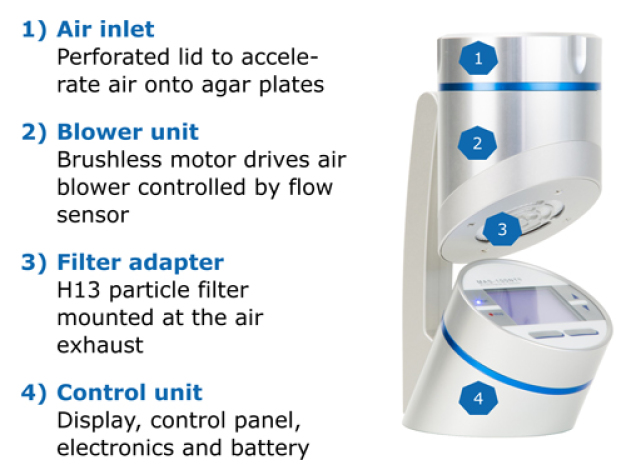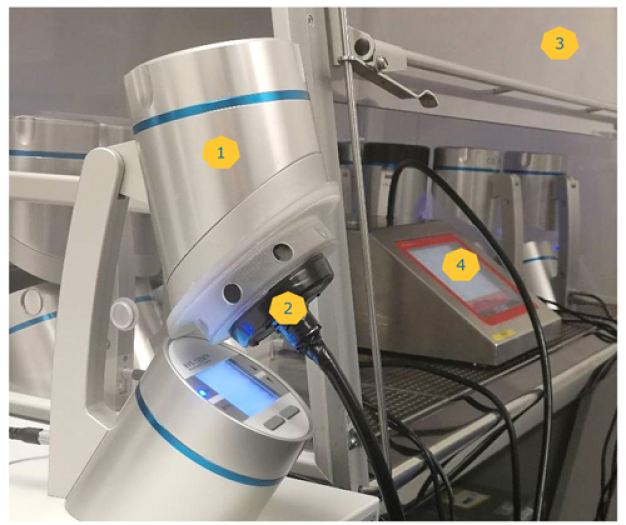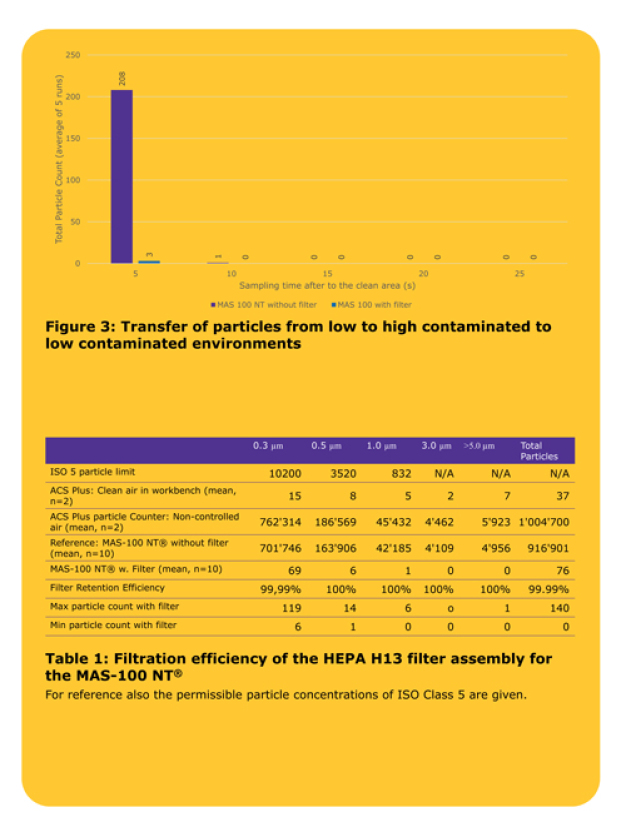- Building technology
Roland Durner, MBV, Switzerland, Tony Ancrum, Anne-Grit Klees, Merck KGaADarmstadt, Germany
Air Outlet Particle Filter For Viable Air Sampler MAS-100 NT®
Introduction
Viable Air Samplers are used for quantitative determination of airborne contamination in cleanrooms and isolators. To maintain the cleanliness of the environment, the air flow should neither disturb the unidirectional air flow nor pose a contamination risk to the environment.
As portable air samplers are sometimes moved and used in various environments with different levels of microbial contamination, there might be a risk of cross-contamination from higher to low contaminated environments.
The MAS-100 NT®is equipped with a brushless motor which generates a minimal amount of particles, so that no filter is required even for GMP Grade A usage. A H13 particle filter can be mounted at the exhaust air, when needed (see Figure 1).
Merck provides results on the cleanliness of MAS®100 NTwith and without in-built filters under several scenarios.
Test Setup
The standard MAS-100 NT®air sampler is compared to a MAS-100 NT®equipped with a H13 filter. The particle emission under different environmental conditions is measured using an ACS Plus particle counter, which directly mounted to the air outlet of the air sampler.
In figure 2 the MAS-100 NT®is positioned in a non-controlled reference environment, whereas in other configurations the instruments is placed beside the ACS Plus particle counter (KM OptoelektronikGmbH, Germany) in the cleanbench.
Results and Discussion
1. CROSS-CONTAMINATION OF CLEANROOMS
Once the test system was established the basic assumption was to be tested: Is there really a need for a filter to prevent the transfer of particle contamination between different environments?
A 1000 l air sample was collected with a MAS-100 NT®in the reference environment with or without filter. Thereafter the instrument was transferred into the clean environment and started again. Particle counts were taken from the exhaust air at the outlet every 5 s. The test was repeated 5 times for both setups In tests without filter we found a total of 126 –296 particles in the first 5 seconds after starting the blower and between 0 and 3 particles for the second 5 seconds and no particles thereafter (Figure 3). A total of 1042 particles were detected between all 5 repetitions, about 12% of them larger than 1 μm. The data demonstrate that there is a minimal transfer of particles between different environments. The fact that there were no particles detected after 10 seconds proves that the particles were not generated by the blower motor or other instrument components.
If the MAS-100 NT®was equipped with a HEPA air outlet filter 0 –6 particles were counted in the first 5 seconds and 0 thereafter (Figure 3), all of them smaller than1 μm. The filter dramatically reduced the transfer of particles and virtually eliminated the risk of them being CFU as those tend to be larger than 1 μm.
2. FILTRATION EFFICIENCY OF THE COMPLETE ASSEMBLY
10 filters on two different units of MAS-100 NT®(5 filters each) were tested for filtration efficiency of the complete assembly of air sampler, filter adapter and HEPA filter. The filter it-self is rated H13 and we expected therefore a filtration efficiency of 99.95% or better for particle sizes of 0.3 μm or larger.For every test we took a reference sample by measuring the particle count of the exhaust air of a MAS-100 NT®running in the reference environment. As the particle load was very high, we took 10 samples of 10 s each and extrapolated the particle count to 1000 l. This reference count was compared to a 1000 l sample taken from the identical MAS-100 NT®with particle filter running in the same environment. Every 3 minutes the particle count was recorded to assess if there was a trend. In all cases the filter assembly passed, and even exceeded, the required performance threshold (Table 1) for H13 filters. Throughout the 36 minutes (approx. 1 m3) sampling interval there was no trend for any filter (data not shown). The filter assembly therefore meets the need to protect an environment from carry-over of particles from another environment with lower particle rating.
3. LONG-TERM FILTRATION EFFICIENCY
It is recommended to recalibrate a MAS-100 NT®annually. Therefore, under normal usage a filter should be able to be used for a complete calibration interval. We assumed that 10 samples of 1000 l per day would be taken under intense usage for 300 days per year. This amounts to about 21 days permanent operation.Two MAS-100 NT®with filter were run continuously for 21 days in the uncontrolled reference environment. From time to time 1 m3of the exhausted air were sampled for particles from both devices and compared to the reference sample taken immediately before or after without filter.There was no detectable deterioration of filtration efficiency during this time. All filters were meeting or exceeding H13 filter specification. Also, there was no detectable filter clogging and airflow calibration remained within specification.
Summary
The MAS-100 NT®is a portable instrument, which is designed for quantitative analysis of microbial contamination in air. The brushless motor does not generate particles, which exceed the limits of a cleanroom ISO 5. This study investigates the need for filtration of the exhaust air, especially when air sampling with the same instrument is performed in environments with various contamination rates.
- There is a risk of minimal transfer of particle carry-over between different environments from air trapped inside a microbial air sampler.
- Particle carry-over is essentially eliminated by the insertion of a HEPA filter at the air outlet of the MAS-100 NT®viable air sampler.
- The filter has no significant influence on the airflow calibration and therefore on the microbial sampling efficiency.
- Stressing the filter for a simulated year of heavy usage in an uncontrolled environment does not reduce the filtration efficiency and does not clog the filter.

MBV AG
Microbiology and Bioanalytic
Industriestrasse 9
8712 Stäfa
Switzerland
Phone: +41 44 9283080
email: welcome@mbv.ch
Internet: http://www.mbv.ch











